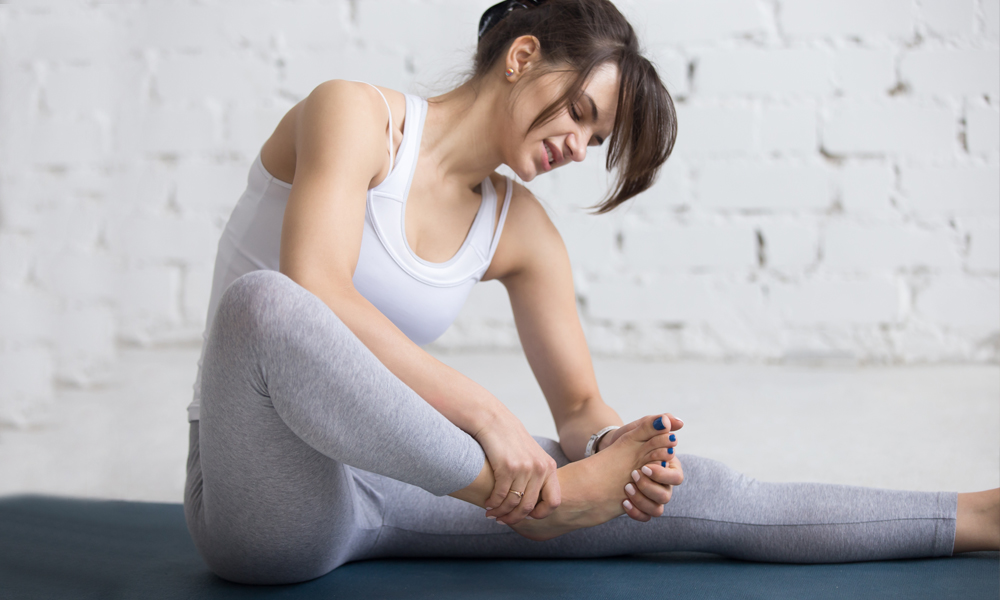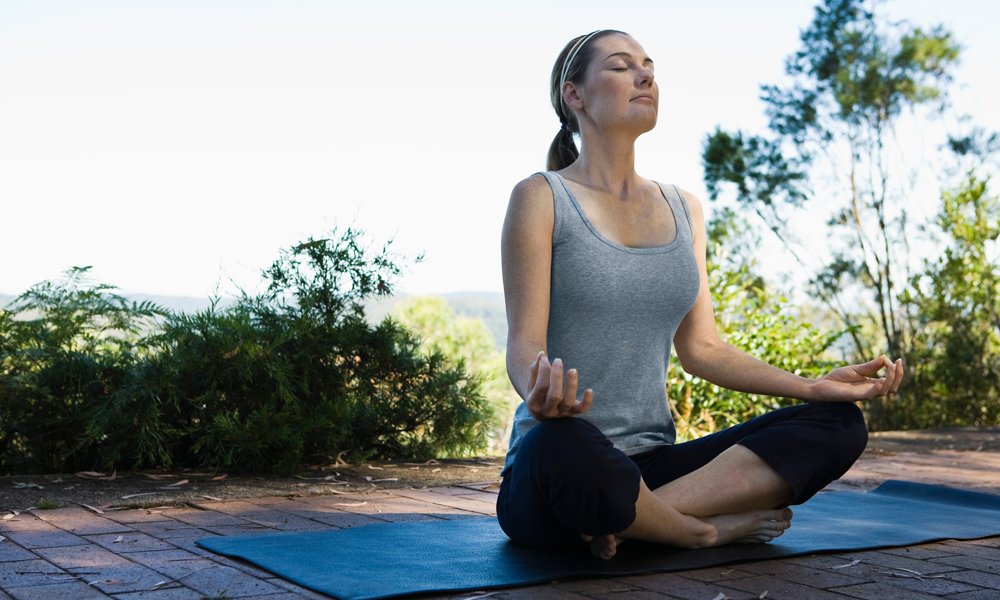A lot of people who attend their first yoga class are a little surprised when they wake up the next morning with sore muscles. Truth be told, most people don’t understand how physical yoga really is until they try it themselves. How bad can poses like sun salutation be?
While some types of yoga therapy focus more on restorative stretching and mediation, there are plenty of asanas that work muscles in your body that you didn’t even know you had. When you do these poses, there’s a good chance you’ll wake up the next day hurting in places you’ve never hurt before, and that’s not necessarily a bad thing.
It may be unexpected, but some pain after yoga practice is usually nothing to worry about. Let’s take a closer look at why it happens, whether or not you can prevent it, and what you can do to feel better.
Contents
Why Does Yoga Hurt at First?
Just about any new exercise causes muscle pain at first, whether it’s yoga, running, or lifting weights. Sore muscles after a workout is a natural part of the recovery process. This pain is often referred to as delayed onset muscle soreness or DOMS.
It’s common when starting a new type of exercise that works new muscle groups, but it can also happen to experienced athletes who change their regular yoga practice or exercise routine by increasing the intensity or duration of their workout.
When muscles stretch and contract in a new way, it’s believed that tiny tears form in the individual muscle fibres. These small tears are believed to cause muscle soreness, but they heal quickly, which is why the pain only lasts for a day or two. Eventually, your body gets used to the new activity, and your muscles don’t hurt after your workout anymore.
This type of pain can happen to anyone, even athletes who have been exercising regularly for a long time if they increase the duration or intensity of their workout. This pain is just your body’s way of adapting to the increased physical demands.
Is Soreness Good or Bad?
Generally, muscle pain after a workout is nothing to worry about, and it should resolve in a day or two. That said, there are some things to keep in mind about how to encourage healing.

Source: canva.com
First, don’t work the same muscle group the next day. They need at least a day to recover and repair. If your muscles are already sore and you push them too hard, you can cause more damage, including muscle injury or exhaustion.
Second, don’t work out as hard as you can every workout. The goal should not be to make your muscles hurt. Yes, sore muscles indicate a good workout, but it’s better to spread your workouts out over several days than to push yourself as hard as you can once or twice a week.
Finally, don’t confuse muscle soreness with pain. Pain is not normal. If you feel any sharp or shooting pain, it’s important to listen to your body and stop the activity before causing a severe injury.
How to Cope with Discomfort
When your muscles hurt after yoga practice, the only thing that will make the pain go away is allowing the fibers to heal, and that takes time. You might have to wait a day or two to feel normal again. This can be extremely discouraging, but don’t give up. The more you practice each yoga posture, the better your body adapts and, eventually, you’ll be able to balance your routine so you feel minimal discomfort afterward.
In the meantime, there are several things you can do to reduce post-yoga soreness.
Heat
A lot of people find a hot water bottle or heating pad effective at soothing muscle soreness. Use moist heat if possible. It’s a little better for loosening tight muscles and easing pain. You should never apply a heating pad or hot water bottle directly to the skin. Always use a towel or other thin piece of fabric to protect yourself from burns.
Ice
Ice is usually recommended for more acute injuries, like sprains or strains, because it reduces pain and slows swelling. That said, some people find it helpful for post-workout soreness as well. When using an ice pack, make sure there’s a barrier between it and your skin and only apply for about 15 to 20 minutes at a time.
Rest

Source: canva.com
Sleep is one of the most restorative things we can do for our bodies. When you sleep, your body rests and repairs itself. Getting a full eight hours of sleep a night gives your body the time it needs to recuperate and heal.
Stay Hydrated
Make sure you drink enough water. This is pretty common knowledge, but you might be surprised by exactly how much water you should drink every day. Men should have close to four litres, women about three. To feel your best, drink between eight and 16 ounces of water about an hour before yoga class and again after.
Soak in the Tub
A warm bath or a soak in the hot tub can also help ease sore muscles. The heat dilates the blood vessels, improving perfusion, and possibly helping your body heal faster. Adding Epsom salts to the bathwater has also been shown to have healing benefits.
Take Your Time
If you’re experiencing muscle soreness from an intense workout, take a break the next day. It’s okay to take the day off from exercise if you have to, or you can choose to do something less strenuous, like taking a brisk walk or swimming laps in the pool.
You can also choose a gentler form of yoga to do on your off days to keep your body moving while letting the affected muscles rest. A lot of people switch between an intense yoga workout one day and something like restorative yoga the next. This is a great way to keep a daily routine while still allowing your body the time it needs to heal.
Massage
Getting a massage can help sore muscles immensely, especially if you go to a trained massage therapist. Rubbing the area brings more blood to the tissue, which can help the muscle heal faster. Depending on where your pain is located, you may be able to massage the area yourself. Topical pain relievers or essential oils can also help ease your pain.
Pain Relievers
If muscle soreness is interfering with your daily activities, you may get relief by taking over-the-counter pain relievers, specifically nonsteroidal anti-inflammatory drugs like ibuprofen or naproxen. These medications can help reduce inflammation and soreness. That said, some people shouldn’t take NSAIDs. Avoid them if you have any liver conditions, stomach ulcers, heart disease, or GI bleeding.
Common Yoga Injury

Source: canva.com
Muscle soreness is one thing, but you also need to know how to differentiate between normal discomfort and a possible injury. Identifying the difference between pain and discomfort is key. Pay attention and listen to your body so you know if what you’re feeling is normal. If your pain gets really bad, it’s a good idea to see a doctor or physical therapist to evaluate for injury. Here are some of the most common yoga injuries to look out for.
Elbows
Joint pain in the elbows is pretty common and results from bending them too far out to the side in poses like low plank. While it might be a little easier to do some poses this way, this position places more pressure and tension on the elbow joint and wrists which can cause an injury.
Instead, keep the elbows tucked close to your ribs with the crease facing forward when doing these poses. You need a lot of upper arm strength to do it this way, so modify the pose if you have to by placing your knees on the floor, making it easier to get into the right position.
Hips
Some asanas, including splits, warrior poses, and forward folds can overextend the hips, causing pain. To avoid this, make sure your toes are pointed forward when doing poses that have the hips squared.
Knee
Even experienced yogis have occasional knee pain, but it’s important to identify the cause and correct the problem to prevent a serious injury. One common cause of knee pain is sitting in cross-legged positions for extended periods of time. The knees and the hips are designed to work together, and if your hip alignment is off, your knees will be the first to feel it.
If you have knee pain, stop sitting cross-legged for long periods of time until your hips are a little more flexible. You can also use a yoga block under the knees to give them additional support. Anytime you’re standing in a pose where the knee is bent, make sure they don’t jut out over the feet too far. Maintain proper alignment by forming a straight line from the heel to the knee when in these positions.
Lower Back
Many yoga poses involve rounding the back which can lead to lower back pain. This causes the spine to flex out, which is the opposite way than it normally does. If done incorrectly, this may cause injuries to the discs resulting in back pain. To avoid this, lengthen the lower spine, pulling it up and away from the hips or bend your knees during the pose if necessary.
Neck

Source: canva.com
Some advanced asanas require headstands, although these are usually quite advanced and not something a beginner should attempt. These poses can cause neck injuries if done incorrectly by putting too much pressure on the neck and compressing the vertebrae.
The best way to avoid an injury like this is not to try it until you’re ready. If you’re a beginner, wait until you have more experience and strength. Or, try them with modifications. If you have a history of a neck injury, avoid this pose altogether or do it only with props and close supervision. Keep the shoulder blades down and back so they are supporting your body instead of relying too heavily on the neck.
Shoulders
Some people have a hard time with shoulder positioning. Pay close attention to your body movements and make it a point not to shrug, always keeping the shoulders down and back. While it might seem innocent enough, raising your shoulders shifts your weight, and you no longer get the benefit of the supporting muscles which makes a rotator cuff or shoulder girdle injury more likely.
Ribs
Overextending during a twist or stretch can damage the muscles between the ribs. Avoid this by stretching the spine before twisting. Imagine someone pulling on a string attached to your head, lengthening your spine and neck. Always twist until you feel the stretch, but don’t push past it.
Wrists
A lot of asanas require you to place most or all of your body’s weight on your wrists. This causes a lot of pressure and stress. One of the best ways to prevent this is to be very aware of how you place your hands. By spreading your fingers wide and pressing through them, you distribute your body weight evenly, one of the best ways to prevent a wrist injury.
Avoiding Pain and Discomfort
Remember, soreness and pain are two very different things. Soreness is normal. Pain that persists or prevents you from performing normal activities can signify a much larger problem.
The biggest thing you can do to avoid pain and injury is not to push yourself. If you’re doing yoga as a way to get physically fit, don’t immediately jump into difficult poses. Even those who are generally fit and do other forms of exercise should approach yoga like a beginner. There is so much to learn, coming into it with a bit of an ego is a mistake.

Source: canva.com
While you cannot always prevent muscle pain, there are a few things you can do to keep it as mild as possible.
Some people assume that yoga isn’t as physical as other forms of exercise and might not think that warming up and cooling down are necessary, but they are. Yoga is just as hard on your body as any other physical activity so stretching before and cooling down after is important.
Don’t jump right into the most difficult asanas. Start with the basics and work your way into more complicated poses. Beginner classes are a good place to get the basics down. There are also classes available for people of all levels. These are good for beginners because you can see what you’re working toward and learn modified poses to use when necessary.
If you have any pre-existing injuries or chronic pain, like a slipped disc, muscle tear or injury, joint issues, or a fracture, talk to your yoga teacher before class. There are plenty of modifications and props you can use to accommodate an old injury so you can still practice yoga without risking further damage. Do not be embarrassed or ashamed to use props, they’re an excellent way to get a little extra support.
When you’re holding a pose for a long time, come out of it slowly to give your body time to adjust. Fast, jerky movements are generally discouraged as part of yoga practice is the slow, graceful movements required to fine-tune body awareness.
Finally, never lock your joints. When you do, you’re hyperextending them which can cause wear and significant damage down the road.
Final Word on Does Yoga Hurt at First
Some muscle pain after yoga is normal, especially if you’re a beginning yoga practitioner. DOMS is a pretty common phenomenon after any intense exercise. Onset is usually between 12 and 24 hours after exercise, and it usually lasts as long as two days.
There’s not much you can do to prevent this type of muscle pain, but a proper warmup and cool down can help. Make sure you stretch before your yoga session and do some relaxing poses at the end.
Once muscle soreness sets in, there are a few ways to cope with it. Over-the-counter pain medications are fine if the aches interfere with your everyday life, but there are plenty of other ways to ease discomfort. Try a warm bath, soak in a hot tub, massage, or a hot water bottle. Make sure you drink enough water and get a full night’s rest. Time is the best cure because your body needs time to heal.
Finally, it’s important to recognize the difference between muscle aches and pain. Muscle aches are perfectly normal, but pain is not. If you feel sudden, sharp pain during your workout, stop right away. Yoga injuries are not uncommon so make sure you take the proper measures to avoid them.
Finally, don’t let muscle aches dissuade you from practicing yoga. A little bit of muscle pain is a sign of a good workout, and if you keep going, your muscles will get stronger and you’ll gain more stamina. Take a break from intense activity and come back to it when your body has recovered. You won’t regret it.
If you liked this post, you might be interested in our guide on the best essential oils for yoga.



